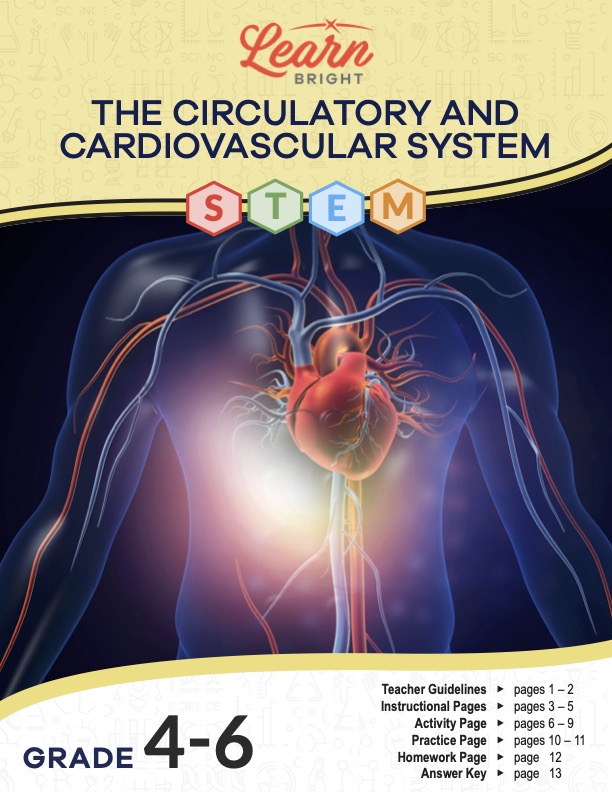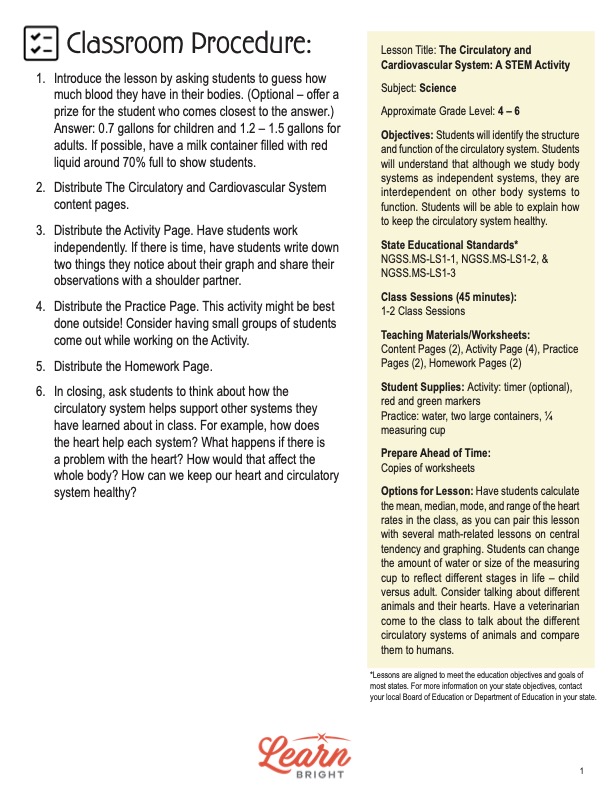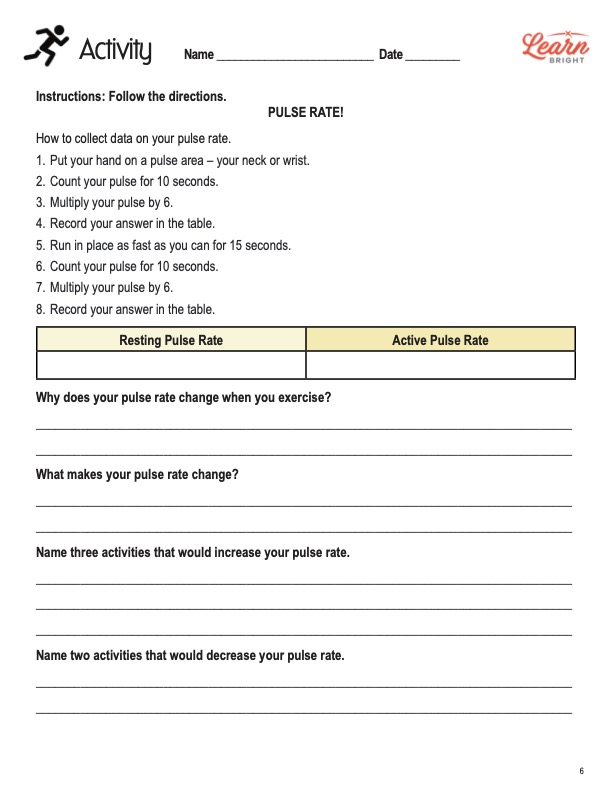Description
What our Circulatory and Cardiovascular System STEM lesson plan includes
Lesson Objectives and Overview: Circulatory and Cardiovascular System STEM teaches students about the structure and functions of this body system. Students will be able to explain how and why to keep the circulatory system healthy. They will also discover how it works with other body systems to function properly. This lesson is for students in 4th grade, 5th grade, and 6th grade.
Classroom Procedure
Every lesson plan provides you with a classroom procedure page that outlines a step-by-step guide to follow. You do not have to follow the guide exactly. The guide helps you organize the lesson and details when to hand out worksheets. It also lists information in the yellow box that you might find useful. You will find the lesson objectives, state standards, and number of class sessions the lesson should take to complete in this area. In addition, it describes the supplies you will need as well as what and how you need to prepare beforehand. For this lesson, you will need red and green markers, water, large containers, and measuring cups. You might also choose to get a timer for the activity.
Options for Lesson
In the “Options for Lesson” section of the classroom procedure page, you will see some suggestions for additional activities or ideas to add to the lesson if you want to. One idea is to have students calculate the mean, median, mode, and range of the heart rates of the students in the class. (You may benefit from pairing this lesson with a math lesson related to central tendency and graphing.) Students could change the amount of water or size of the measuring cup to reflect different stages in life—child versus adult—during the practice. Consider talking about different animals and their hearts and how they differ from those of humans. Another option is to have a veterinarian come to the class to talk about the different circulatory systems of animals and compare them to humans.
Teacher Notes
The teacher notes page provides an extra paragraph of information to help guide the lesson. You can use the blank lines to write down any other ideas or thoughts you have about the topic as you prepare.
CIRCULATORY AND CARDIOVASCULAR SYSTEM STEM LESSON PLAN CONTENT PAGES
Introduction to the Heart
The Circulatory and Cardiovascular System STEM lesson plan has three pages of content. Students will first learn what this body system actually is. The circulatory system comprises the heart, blood vessels, and blood. There are two circulatory systems in the human body: pulmonary circulation and systemic circulation. With pulmonary circulation blood loops from the heart to the lungs and back. And with systemic circulation, it loops from the heart to all the other parts of the body and back.
With each heartbeat, blood travels throughout the body to carry oxygen and nutrients to the cells. Without blood, we wouldn’t be alive! This is why the heart has to pump blood continuously through the body. The heart is the main organ in the circulatory system. It is a muscle about the size of a fist on the left side of the chest. Its job is to propel blood throughout the body.
Each minute, the heart beats anywhere from 60 to 100 times, but it can go even faster than that if needed. The body sends the heart signals to pump more (or less) blood depending on the situation. For example, exercising or being scared tells the heart to pump faster to get more oxygen. But when we sleep, our body tells the heart to slow down. Each day, the heart beats around 100,000 times. That’s 30 million times a year and over 2.5 billion times over an average lifespan.
Parts of the Heart
The heart has four chambers: two ventricles and two atria. The bottom two chambers are the ventricles, which are separated by a wall called the interventricular septum. Ventricles are responsible for pumping blood out of the heart. The upper two chambers of the heart are the atria. Atria have the opposite job as ventricles and receive blood as it enters the heart. The wall between them is the interatrial septum. In addition, four sets of valves in the heart ensure that the blood can only flow in one direction.
Blood enters the heart through the right atrium, passes down to the right ventricle through the tricuspid valve, and flows through the pulmonary artery. It flows through the pulmonary artery to the lungs, where it gathers oxygen and removes carbon dioxide. The aorta is the main artery that takes away blood. Something called the mitral valve separates the left atrium and left ventricle, taking away blood from the heart.
Blood Vessels
Next, students will learn about blood vessels. Blood vessels constantly circulate blood throughout the body. As the blood circulates, it picks up nutrients from food and drops them off to the cells that need energy. Then it takes the waste from the cells (carbon dioxide) and drops it off in the lungs so we can breathe it out.
Blood vessels are tubes that run through the entire body to help carry the blood. Some of these are veins, which bring blood to the heart. Others are arteries, which take blood away from the heart. Arteries have to be super strong and thick because there is more pressure on them from the heart’s pumping. Veins don’t have to be as wide because they carry the blood back to the heart.
Our blood consists of red blood cells, among other things. Red blood cells carry oxygen, which is why it looks red. Blood also contains platelets that help our blood clot when we get a cut. In addition, it has white blood cells, which are responsible for killing germs and keeping the blood free from invaders. The red blood cells, white blood cells, and platelets float around in a substance called plasma. Together they make up our blood.
There are four main types of blood—A, B, O, and AB. Each type is slightly different from the others because of antibodies and antigens. If a person needs a blood donation, they must receive blood that matches their blood type. If the blood types do not match, the person receiving the blood can get very sick.
Keeping the Circulatory System Healthy
The circulatory system works with all the other systems in the body to help supply nutrients and remove waste. Our heart is an essential part of the system as it pumps blood throughout our bodies. It is necessary to keep it healthy and working well for our whole life.
Like all muscles, we can strengthen the heart through regular exercise. For example, a brisk 10-minute walk can increase the blood flow through the heart and make it stronger. Avoiding foods that are heavy in fat and sugar can also help our circulatory system remain healthy. On the flip side, eating healthy foods and snacks like natural fruits and vegetables can strengthen our heart and circulatory systems.
Excessive stress can hurt the circulatory system because it increases the levels of chemicals in the bloodstream that injure the cells. Deep-breathing exercises and learning to manage stress are part of a heart-healthy plan. Infections can be hard on the circulatory system as well. A good habit is to wash the hands often to reduce the chances of getting sick from the flu or other diseases.
CIRCULATORY AND CARDIOVASCULAR SYSTEM STEM LESSON PLAN WORKSHEETS
The Circulatory and Cardiovascular System STEM lesson plan includes three worksheets: an activity worksheet, a practice worksheet, and a homework assignment. Each one will help students solidify their grasp of the material they learned throughout the lesson. You can refer to the classroom procedure guidelines to know when to hand out each worksheet.
PULSE RATE ACTIVITY WORKSHEET
For the activity, students will collect data on their own pulse rate. First, they will put their hands on either their neck or wrist and count their pulse for 10 seconds. After multiplying that number by 6 to get their beats per minute, they will record the answer in the table. Students will then run in place as fast as they can for 15 seconds. Again, they will count their pulse for 10 seconds, multiply by 6, and record the answer in the table.
The worksheet lists four prompts regarding the data students collected about their pulse. They must explain why the rate changed after exercising and describes things that make a pulse rate change. Then they will list three activities to increase their pulse rate and two that decrease it.
On the second worksheet page, students will collect the heart rate data from four other students and fill in their information in the table. Finally, they will create a bar graph showing each students resting pulse rate in green and active pulse rate in red.
CIRCULATORY AND CARDIOVASCULAR SYSTEM STEM PRACTICE WORKSHEET
The practice worksheet requires students to see if they can work faster than their hearts. Students will first read a short passage at the top of the page about how much blood the heart pumps through their body every day. They will fill a container with one gallon of water and set a timer for one minute. Then they will use a small cup to scoop water into another container as fast as possible. Another students will count the scoops. At the bottom of the worksheet are four prompts for students to respond to.
EXERCISES HOMEWORK ASSIGNMENT
For the homework assignment, students will mark off spots on a tic-tac-toe board as they complete the exercise on that spot. They should do as many of each exercise as they can for two minutes. Then they will check their heart rate after each exercise and record the beats per minute in the box. Exercises include jumping jacks, push-ups, squats, and jogging in place.
Worksheet Answer Keys
The lesson plan document provides answer keys for the three worksheets. All the correct answers are in red to make it easier for you to compare them with students’ work. Some of the prompts on various worksheets are objective, so students’ answers will vary. The answer keys often provide sample responses in these cases. If you choose to administer the lesson pages to your students via PDF, you will need to save a new file that omits these pages. Otherwise, you can simply print out the applicable pages and keep these as reference for yourself when grading assignments.









